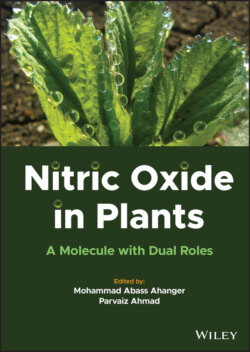Читать книгу Nitric Oxide in Plants - Группа авторов - Страница 28
2.5.1 Drought and Low Mineral Nutrient Supply
ОглавлениеDuring water deficit, plant functioning (plant growth and photosynthesis) is affected adversely. However, through stomatal closure, plants can overcome a temporary drought. But in long-term drought situations, suppressed leaf expansion, leaf excision, and changes in root morphology have been observed. The vulnerability of different plants to water deficiency is largely dependent upon their structural and physiological modifications to water stress (Santisree et al. 2015).
It has been speculated that slight water deficiencies lead to an increased level of NO production in the roots of cucumber plant. Pretreatment with extrinsic NO, e.g. 100 μM sodium nitroprusside (SNP) and GSNO was capable of neutralizing drought-induced membrane impairment and peroxidation of lipid in water-deficient plants. SNP (200 μM), an NO donor, has also been recognized to employ a shielding effect (improved growth, rise in water content, and less oxidative destruction) in wheat plantlets under polyethylene glycol-induced water stress (Zeppel et al. 2015). The capability of NO to manage drought stress might be linked to its direct effect as an antioxidant, the effects on root physiology, and a role in closure of stomata. In guard cells, NO is involved in the stimulation of intracellular Ca2+release, and regulates Ca2+-sensitive K+ and Cl− channels in the plasma membrane (Simontacchi et al. 2015).
In agriculture, one limitation is the low accessibility of some essential nutrients, which delivers varied surroundings to the plant. Plants have numerous mechanisms to extract minerals from the soil including major changes in the root growth pattern, the improved ability to obtain nutrients from depleted environments, and also the release of different substances that facilitate nutrient availability in the close proximity of roots, thus favoring their accumulation by roots. Recent study indicates that NO is involved in the modulation of these aforementioned mechanisms (Lambers et al. 2011). For example, in white lupin (Lupinus albus) at low phosphorus levels, the contribution of NO in plant responses has been observed and confirmed. Along with this plant, in other dicots and monocots, phosphorus deficiency mediates root branching followed by the release of exudates, comprising organic acids (Wang et al. 2014), which facilitate plants to increase P acquisition. From this perspective, it has been indicated that white lupin roots exposed to P deficiency exhibited heightened accumulation of NO, which was directly linked to the clustering of roots and increased exudation of citrate compounds. Sequentially, the addition of NO donors (e.g. SNP and GSNO) leads to the propagation of cluster roots, whereas NO scavengers (e.g. cPTIO [2-4-carboxyphenyl-4,4,5,5-tetramethylimidazoline-1-oxyl-3-oxide]) eradicate this progression (Palavan-Unsal and Arisan 2009).
